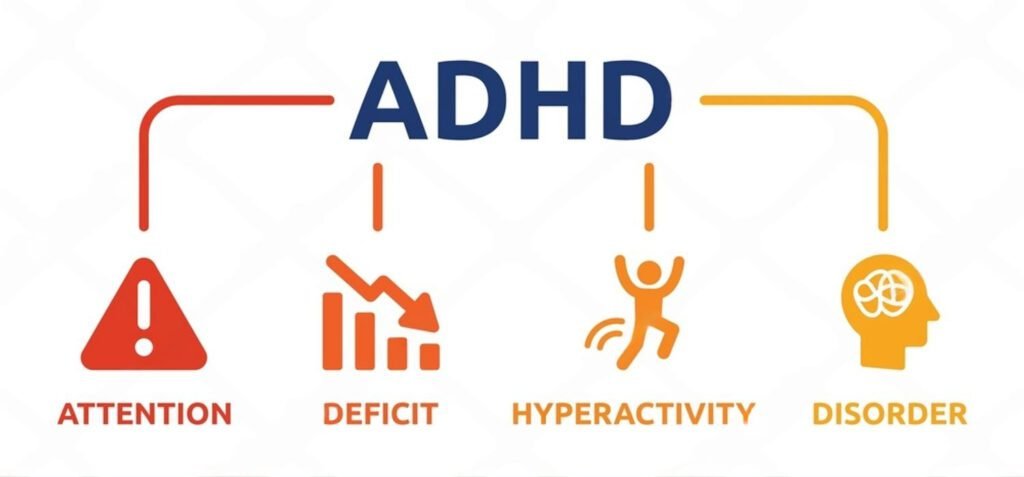Ever wondered why you struggle to focus at work while your coworkers seem to breeze through tasks? Attention deficit hyperactivity disorder (ADHD), also known as adult ADD, affects between 2.5% and 6.76% of adults worldwide, impacting approximately 139 to 360 million people. Yet many adults with this attention deficit disorder don’t even know they have it, leading to cases of undiagnosed or suspected ADHD. Learn more about the condition in our essential guide to ADHD to understand its core features.
Table of Contents

What Are ADHD Symptoms in Adults?
ADHD symptoms in adults can manifest in various ways, often leading to challenges in both personal and professional settings. Common signs include chronic disorganization, difficulty prioritizing tasks, and a tendency to procrastinate, which can create a cycle of stress and frustration. Additionally, many adults may experience emotional dysregulation, making it hard to manage feelings of overwhelm or impatience. These attention difficulties can significantly impact an individual’s productivity and performance in various aspects of life.
Understanding Adult Attention-Deficit/Hyperactivity Disorder
Adult attention-deficit/hyperactivity disorder (ADHD) is a neurodevelopmental condition that begins in childhood and often persists into adulthood. But what is ADHD exactly? It’s characterized by a persistent pattern of inattention, hyperactivity, and/or impulsivity that interferes with daily functioning in at least two areas of life.
Based on symptoms, ADHD is diagnosed as one of three types:
- Predominantly inattentive type: Difficulty focusing, staying on task, or being organized
- Hyperactive-impulsive type: Excessive activity, restlessness, and acting without thinking
- Combined type: Showing symptoms of both inattention and hyperactivity-impulsivity
In adults, these ADHD traits can manifest as disorganization, procrastination, poor time management, trouble completing projects, forgetfulness in daily activities, and difficulty maintaining relationships. Although some people outgrow childhood ADHD, many don’t—approximately one-half to two-thirds of children with ADHD continue to experience symptoms into adulthood, which may present as mild ADHD or more severe forms.
Why ADHD Often Goes Undiagnosed in Adults
Despite its prevalence, fewer than 20% of adults with ADHD are accurately diagnosed and treated. Several factors contribute to this underdiagnosis:
First, ADHD symptoms evolve with age. While hyperactivity often decreases or transforms into internal restlessness, inattention symptoms typically persist. Consequently, adults may not recognize their struggles as ADHD since they don’t match the stereotypical hyperactive child.
Furthermore, many adults develop compensatory strategies that mask their symptoms. These might include working twice as hard as peers, creating elaborate organizational systems, or relying on external support.
Additionally, ADHD frequently co-occurs with other mental health conditions—up to 80% of adult “ADHDers” have another disorder alongside their ADHD. Anxiety, depression, or substance abuse disorders can obscure underlying ADHD symptoms or develop as a result of untreated ADHD. You can explore related co-occurring symptoms in the Ultimate Guide to Depression Therapy for more support.
Notably, ADHD is especially likely to be missed in women, who more commonly show inattentive symptoms rather than the more visible hyperactive behaviors. This disparity begins to equalize in adulthood as more women seek diagnosis, highlighting the importance of recognizing ADHD in women.
Key Signs of Inattentive ADHD in Adults
Inattentive ADHD presents differently than the hyperactive stereotype many associate with this condition. The subtle nature of these symptoms often leads to misdiagnosis or dismissal as mere personality traits. Discover Hidden ADHD Symptoms that are often missed by doctors and even individuals themselves.
Difficulty Focusing and Sustaining Attention
Research confirms people with ADHD display significant deficits in selective and divided attention. Unlike occasional distraction, this represents a fundamental neurological difference – ADHD brains have naturally lower levels of dopamine and norepinephrine, the neurotransmitters controlling attention. This manifests as profound difficulty maintaining focus on tasks perceived as uninteresting. Ironically, many adults with inattentive ADHD can hyperfocus on engaging activities while being unable to direct this focus where needed. One person described it as: “I obsess about something absolutely irrelevant and ridiculous, like how someone pronounced a word”.
Frequent Forgetfulness and Poor Time Management
Forgetfulness in adult ADHD extends beyond occasionally misplacing keys. It involves consistently struggling with:
- Missing deadlines and bill payments
- Chronically arriving late to appointments
- Frequently losing essential items
- Forgetting birthdays and significant events
This stems partly from “time blindness” – a different perception of how time passes. As one adult with ADHD explained, “Time blindness has made me late to weddings, funerals, and most appointments”. These memory challenges aren’t caused by laziness but by differences in how information is processed and stored.
Struggling with Follow-Through and Instructions
Perhaps most frustrating is the difficulty completing tasks and following multi-step instructions. Adults with ADHD often begin projects enthusiastically but struggle to maintain momentum. “My biggest challenges are staying on task, procrastinating, socializing, and remembering that I’m not lazy. My symptoms make it easy to get behind, get overwhelmed, and then get burned out,” shared one adult with ADHD. This challenge with follow-through isn’t from lack of motivation but from executive dysfunction – difficulty with the cognitive abilities needed to achieve goals. Many report putting off important tasks that require sustained mental effort, sometimes until situations become urgent.
Hyperactivity and Impulsivity Symptoms in Adults
While many associate ADHD with the hyperactive child who can’t sit still, these symptoms persist into adulthood for many people—even though they may look different than they did in childhood. Studies show that hyperactivity and impulsivity symptoms often decline with age but remain significant enough to impact daily life.
Restlessness and Constant Movement
Adults with hyperactive ADHD often describe feeling like their “internal motor won’t shut off”. This restlessness manifests as:
- Frequent fidgeting, leg bouncing, or pen tapping
- Difficulty remaining seated during meetings or meals
- Feeling uncomfortable when expected to stay still
- Constant busy behavior or seeming always “on the go”
One distinctive trait is the need for constant stimulation or activity. Indeed, many adults with ADHD report feeling genuinely uncomfortable during quiet activities or downtime. This isn’t simply boredom—it’s a neurological need for movement and stimulation. Fidgeting in ADHD is often a way for individuals to self-regulate and maintain focus.
Interrupting Conversations and Acting Without Thinking
Impulsivity in conversation represents one of the most socially challenging aspects of adult ADHD. This often leads to:
Cutting others off mid-sentence, finishing people’s thoughts, or blurting out answers before questions are completed. Importantly, these interruptions aren’t intentionally rude—they stem from a combination of poor impulse control and working memory challenges.
Many adults with ADHD report interrupting because they fear forgetting their thought if they don’t express it immediately. This creates social tension as others may interpret these behaviors as self-centered when they’re actually symptoms of executive dysfunction.
Emotional Outbursts and Poor Impulse Control
Emotional regulation difficulties remain among the most overlooked aspects of adult ADHD. Adults with ADHD often experience:
Rapid mood shifts, disproportionate emotional responses, and difficulty calming down once upset. This stems from challenges with executive function—the brain’s ability to regulate emotions and control impulses. Outbursts of anger may occur more frequently in individuals with ADHD due to these emotional regulation difficulties.
FMRI studies reveal that in ADHD brains, emotional responses often remain dominant because the attention network doesn’t activate properly to mediate these emotions. This explains why adults with ADHD may react impulsively to emotional triggers before having time to process them rationally.

Executive Dysfunction: The Hidden ADHD Struggle
Essentially, ADHD is an executive function deficit disorder (EFDD). These invisible cognitive processes form the foundation of almost every daily task—and their dysfunction explains why many adults with ADHD struggle despite knowing exactly what they need to do.
Trouble Starting or Completing Tasks
“It is not that the individual does not know what to do. It is that somehow it does not get done,” explains ADHD researcher Dr. Russell Barkley. This concept is supported by CDC’s overview of adult ADHD, which outlines how ADHD affects daily functioning. This paradox causes profound frustration. Many adults with ADHD describe starting tasks as “viscerally painful” or like “pushing a car uphill while hopping on one foot”.
The science explains why: dopamine levels in the ADHD brain correlate directly with interest level. Without sufficient dopamine, the brain literally cannot activate for boring tasks, creating a state of “hypofocus”. Conversely, interesting activities can trigger “hyperfocus”—making the ADHD brain’s functional range much wider than neurotypical brains, with a smaller “sweet spot” for intentional focus.
Poor Organizational Skills
Research shows adults with ADHD score 10-15 points lower on executive function skills measures than those without the condition. These deficits surpass intelligence as predictors of academic success. Organizational challenges manifest as:
- Habitual forgetfulness and missed deadlines
- Difficulty following multi-step directions
- Problems managing materials and setting schedules
- Trouble adapting to changing circumstances
Studies indicate approximately 40%-60% of adults experience significant executive function challenges, affecting critical areas like time management and decision-making.
Difficulty with Planning and Prioritizing
Breaking down complex tasks presents a particular challenge. “I overthink the whole process before I even begin. I feel ashamed that such small tasks can be utterly paralyzing,” reports one adult with ADHD.
This planning paralysis stems from developmental delays—those with ADHD typically show 30-40% slower development in executive functions. Consequently, their decision-making often prioritizes immediate rather than long-term rewards.
Many struggle with ambiguity in tasks, feeling overwhelmed without clear steps. As one ADHD adult explains: “Finding the motivation to start something is excruciating. Hyperfocus helps, but I spend days beating myself up for being behind”.

How Adult ADHD Symptoms Differ From Children’s
ADHD symptoms transform significantly from childhood to adulthood, often becoming less visible yet more complex. Research shows that adults typically experience a 50% reduction in hyperactivity symptoms compared to childhood, yet internal restlessness and inattention persist at nearly full strength.
Emotional Regulation and Social Challenges in Adults
Adults with ADHD face unique emotional challenges that children rarely experience. Approximately 70% of adults with ADHD struggle with emotional dysregulation—difficulty managing emotional responses appropriately. This manifests as mood swings, irritability, and heightened sensitivity to rejection. Moreover, social consequences become more severe; whereas hyperactive children might be labeled “energetic,” adults face relationship difficulties, job instability, and increased divorce rates.
The “rejection sensitive dysphoria” phenomenon—intense emotional pain when perceiving rejection—affects nearly all adults with ADHD yet remains virtually unrecognized in diagnostic criteria. Many describe this as “my primary struggle” despite it receiving minimal clinical attention. Social consequences can also increase. For strategies to support your emotional and cognitive well-being, read How to Improve Mental Health.
Co-occurring Conditions: Anxiety, Depression, and More
Certainly, the prevalence of co-occurring conditions increases dramatically in adulthood. Up to 80% of adults with ADHD have at least one additional mental health disorder, compared to about 50% of children. Depression appears in 35-50% of adult ADHD cases, anxiety disorders in 40-60%, and substance use disorders in 15-25%—rates far exceeding those in children. Other conditions like bipolar disorder, personality disorders, and mood disorders may also co-occur with ADHD.
These comorbidities often develop directly from untreated ADHD symptoms. Undiagnosed adults frequently develop anxiety from constantly trying to compensate for ADHD challenges, or depression from years of perceived failure and criticism.
Subtle Presentation and Internalized Struggles
Adult ADHD typically becomes more internalized and subtle. Whereas children’s symptoms appear as obvious behavioral problems, adults primarily experience internal chaos—racing thoughts, difficulty relaxing, and chronic self-doubt. Many compensate through perfectionism, overwork, or extreme organizational systems that mask underlying difficulties.
This internalization makes diagnosis particularly challenging. Primarily, women with ADHD often remain undiagnosed until adulthood because their symptoms manifest as apparent anxiety, perfectionism, or “trying too hard” rather than disruption. Regardless of gender, many adults learn to hide their struggles, developing what researchers call “masking behaviors” that conceal symptoms but contribute to burnout and psychological distress.
Managing ADHD Symptoms: Strategies That Help
Finding effective strategies to manage ADHD symptoms can transform daily life for adults with this condition. Research shows that a combination of treatments typically works better than any single approach alone.
Cognitive Behavioral Therapy (CBT) and Professional Help
Cognitive Behavioral Therapy stands out as a powerful tool for adults with ADHD. If you’re unsure where to begin, check how to find a qualified therapist who specializes in ADHD diagnosis and management.
This structured counseling teaches specific skills to manage behavior and transform negative thinking patterns. In fact, CBT is the only individual psychosocial treatment for adult ADHD with empirical support from randomized controlled trials.
Most CBT approaches for ADHD follow a modular structure addressing common impairment domains:
- Psychoeducation and organizing/planning
- Strategies for coping with distractibility
- Adaptive thinking techniques
- Optional modules for procrastination and partner involvement
CBT helps adults with ADHD develop crucial skills like time management, organization, and stress management. For instance, therapists work with clients to establish calendar systems, prioritize tasks, and create problem-solving skills. These techniques specifically target executive function challenges that medication alone cannot fully address.
Lifestyle Adjustments and Time Management Tools
ADHD expert Russell Barkley notes that “ADHD is not a disorder of knowing what to do, it’s a disorder of doing what you know”. Therefore, practical time management strategies are essential.
First and foremost, regular exercise produces significant benefits—when you exercise, your brain releases dopamine, naturally improving attention and concentration. Meanwhile, adequate sleep serves as a powerful tool for regulating mood and maintaining attention throughout the day. Many adults with ADHD experience sleep problems, so addressing these issues can be crucial for symptom management.
For organizational challenges, simple approaches often yield the best results:
- Breaking tasks into smaller, manageable steps
- Using sticky notes for visual reminders
- Maintaining consistent daily routines
- Creating external accountability systems
Medication and Natural Support Options
Medication remains a cornerstone of ADHD treatment. Stimulants like methylphenidate and amphetamine typically serve as first-line ADHD medications, working by boosting neurotransmitter levels. Non-stimulant options include atomoxetine and certain antidepressants for those who can’t tolerate stimulants.
Nevertheless, natural approaches can complement medical treatment. Some studies indicate yoga and tai chi may help improve ADHD symptoms. Mindfulness meditation has also shown promise in improving mood and attention in adults with ADHD.
Subsequently, nutritional support through omega-3 supplements may benefit some individuals, although research results remain mixed. Above all, remember that what works best varies among individuals—finding the right combination often requires patience and professional guidance from a healthcare provider or mental health professional.
When to Seek Diagnosis and Treatment for ADHD
Reaching out for professional help is often the first step toward regaining control when ADHD symptoms consistently disrupt your daily life. Most importantly, ADHD is diagnosed only when symptoms cause ongoing problems in more than one area of your life.
Recognizing Clinical Criteria and Diagnostic Process
For adults to receive an ADHD diagnosis, they must exhibit at least five symptoms of inattention and/or hyperactivity-impulsivity that interfere with functioning. These symptoms must:
- Be present for at least 6 months
- Exist in two or more settings (work, home, social)
- Have started before age 12
- Not be better explained by another mental health disorder
According to diagnostic guidelines, symptoms must cause significant impairment in at least two major settings. Without this impairment, even with many symptoms, a clinical diagnosis may not be warranted. The NIMH ADHD resource provides evidence-based criteria and recommended evaluations.
What to Expect During an ADHD Evaluation
An ADHD evaluation isn’t a single test but a comprehensive process. Firstly, it typically involves a structured interview covering your symptoms, medical history, and family background. Your doctor will likely request you complete standardized behavior rating scales and questionnaires.
In order to rule out other conditions, your evaluation might include:
- A detailed review of your developmental history
- Discussion of symptoms in various settings
- Assessment for co-occurring conditions like anxiety or depression
- Possible medical examination
This process generally takes between one to three hours, although gathering all necessary information might extend over multiple appointments. A psychologist, psychiatrist, or other mental health professional specializing in ADHD can conduct this evaluation.
How to Advocate for Yourself or a Loved One
Prior to your evaluation, gather documentation that supports your concerns. School records, job evaluations, and notes about your symptoms can provide valuable context. Besides bringing these materials, consider asking a spouse, family member, or close friend to participate in parts of the evaluation.
Whenever seeking evaluation, be open and honest about your struggles. Many adults with ADHD feel shame about their symptoms, but withholding information can affect diagnostic accuracy. Accordingly, seek providers with specific training and experience in adult ADHD, as diagnosis can be challenging due to symptom overlap with other conditions.

Final Thoughts: Recognizing and Supporting Adult ADHD
Living with adult ADHD presents unique challenges that extend far beyond occasional forgetfulness or restlessness. Throughout this article, we’ve explored how ADHD manifests differently in adults compared to the stereotypical childhood presentation, affecting between 2.5% and 6.76% of adults worldwide. Undoubtedly, many struggle silently without proper diagnosis or treatment.
ADHD fundamentally impacts executive function—those invisible cognitive processes controlling attention, organization, and emotional regulation. Therefore, symptoms like difficulty focusing, poor time management, and emotional dysregulation represent neurological differences rather than character flaws or lack of effort. This realization alone provides significant relief for many adults who have spent years blaming themselves.
Although ADHD cannot be cured, effective management strategies exist. Cognitive Behavioral Therapy stands out as particularly effective for developing practical skills to navigate executive dysfunction challenges. Additionally, lifestyle adjustments such as regular exercise, consistent routines, and external organizational systems help compensate for ADHD-related difficulties. Many adults also benefit significantly from medication, which addresses the neurochemical imbalances underlying their symptoms.
Perhaps most importantly, understanding adult ADHD leads to self-compassion. After years of negative feedback and self-criticism, recognizing these struggles as symptoms rather than personal failings transforms one’s self-perception. While ADHD certainly presents challenges, it also offers unique strengths—creativity, problem-solving abilities, and moments of hyperfocus that can yield extraordinary results when properly channeled.
If you suspect you might have ADHD, consider seeking professional evaluation. Early diagnosis and appropriate treatment can prevent secondary issues like anxiety and depression while significantly improving quality of life. Remember—ADHD doesn’t define your potential, but understanding it better equips you to thrive despite its challenges.
FAQs
What are the most common symptoms of ADHD in adults?
Common symptoms of ADHD or signs of ADHD include difficulty focusing, poor time management, forgetfulness, disorganization, restlessness, impulsivity, and emotional dysregulation. Adults may struggle with completing tasks, following instructions, and maintaining relationships.
How does ADHD in adults differ from ADHD in children?
Adult ADHD symptoms are often more internalized and subtle. While hyperactivity may decrease, inattention and impulsivity often persist. Adults typically experience more emotional regulation difficulties and face greater social and professional consequences.
What treatment options are available for adults with ADHD?
Treatment often involves a combination of approaches, including medication (stimulants or non-stimulants), Cognitive Behavioral Therapy (CBT), lifestyle adjustments, and organizational strategies. Some individuals also benefit from mindfulness practices and nutritional support.
How is ADHD diagnosed in adults?
Diagnosis involves a comprehensive evaluation, including a structured interview, behavior rating scales, and assessment of symptoms in multiple life areas. Professionals look for at least five symptoms of inattention and/or hyperactivity-impulsivity that have persisted for at least six months and cause significant impairment.
Can ADHD develop in adulthood?
ADHD doesn’t develop in adulthood; it’s a neurodevelopmental disorder that begins in childhood. However, many adults are diagnosed later in life as symptoms may have been overlooked or masked earlier. Approximately one-half to two-thirds of children with ADHD continue to experience symptoms into adulthood.









